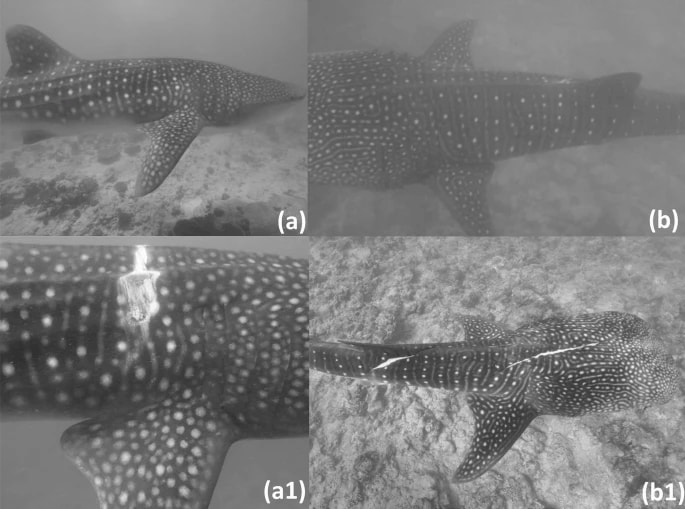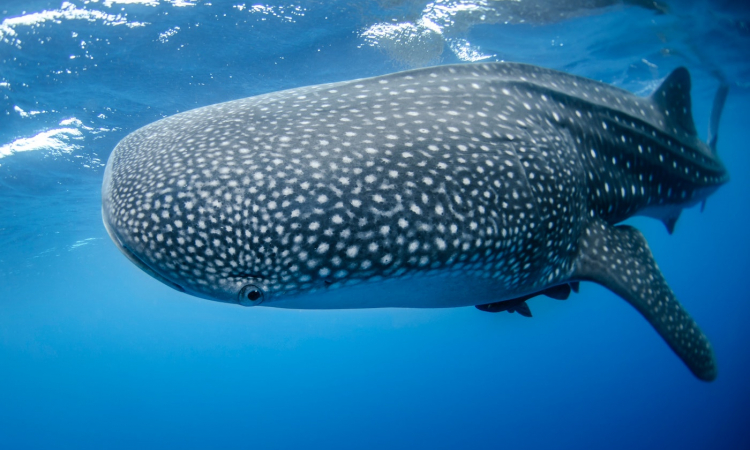Modelling of whale shark (Rhincodon typus) population trends, in a Marine Protected Area (MPA) in the Maldives, has linked changes in animal behaviour to injuries caused by boat strikes.
The work is based on 13 years of dedicated surveying by the conservation charity; Maldives Whale Shark Research Programme (MWSRP), along with citizen science data. It marks the first confirmation that human activities are altering the life history of whale sharks within an MPA. The work poses difficult questions for the regulation of boat traffic and wildlife tourism within protected areas.
Whale sharks are the largest fish in the ocean, reaching lengths above 18m and weighing in at more than 19,000kg. Despite their size, whale sharks are filter feeders, with throats incapable of swallowing anything larger than a thumb-sized sprat. The slow-moving grace of the creatures, and their seeming indifference to the presence of humans, ensure their position on the encounter bucket list of snorkelers, divers, and swimmers around the world.
In the past, whale sharks were easy targets for fisheries, who harvested their meat and oil from their fatty livers. The international demand for shark fins means that the fish are still targeted in many areas of the world. Efforts to conserve whale sharks have aimed to shift the focus away from catching them towards ecotourism. Nowhere is this more evident than in the South Ari Atoll MPA in the Maldives. Here, whale sharks were a cornerstone of the economy prior to the COVID-19 pandemic, bringing in 9.4 million USD at the last estimate in 2013. Tourism has made the health of sharks and in particular whale sharks a concern for a large proportion of the local community. Unfortunately, the loss of income from tourism in 2020 has seen an upsurge in illegal shark hunting and finning, threatening conservation efforts.
The waters around the South Ari Atoll are one of the very few places in the world where the usually transient species takes up semi-permanent residence. Most of the individuals in the area are immature males, and the MPA is often referred to as a ‘developmental habitat.’ Jessica Harvey-Carroll, a PhD student at St Andrews University, and first author of the paper discussed the importance of these habitats; “Places like the South Ari Atoll MPA give young sharks somewhere to build up strength, before moving off into the wider ocean. For us, this gives us a rare opportunity to study the behaviour of individual sharks for long periods of time.”
This opportunity is coveted by marine biologists and conservationists alike. Despite public interest, and an ecotourism industry which had been blossoming, the biology and ecology of whale sharks remains a mystery. We are yet to identify where whale sharks give birth to their young, or even confirm where they mate. This is a roadblock for conservation. Harvey-Carroll explained; “We need to know as much as possible to protect the species properly. In the past, we assumed that tourist attention had very little impact on the sharks, but more and more we’re beginning to understand that we’re altering their behavior with our presence.”

Example images of new major injuries obtained within estimated residency periods (a,a1) and outside of estimated residency periods (b,b1). This shark (WS180) was documented on 26.03.14 with no major injuries (a). A major impalement injury was present when the shark was next observed 6 days later on the 01.04.14 (a1). (b) This shark (WS077) was documented on 14.01.12 with no major injuries. (b1) The next sighting of WS077 (Photo credit: Big Fish Network) occurred 122 days later on the 15.05.12, and major lacerations were present. Images taken by MWSRP.
Harvey-Carroll’s paper reported an overall decline in whale shark abundance in the South Ari Atoll MPA. This falls in line with global trends for the endangered species. Worryingly, they found that 61% of sharks had severe injuries. “Whale sharks spend a lot of time cruising just below the surface of the ocean, feeding on plankton and small animals. Unfortunately, this puts them right in the path of boats.” Harvey-Carroll stated: “There can be little doubt that most injuries are caused by human activity. We see everything, from abrasions caused by hulls to fins cut off by propellors.”
The authors modelled how long whale sharks were staying in the MPA, and how this related to injuries. They found that sharks which had severe injuries spent longer in the area than those without. They theorize that injured sharks remain in the area as they recover, delaying their development and entry into the global population. “This is a really significant step in our understanding”, said Harvey-Carroll. “Sharks are amazing healers, but what we’ve shown is that even if an injury doesn’t kill them, it really alters their life history.” Injuries can occur before the animals arrive in the MPA, with larger animals being more likely to have an injury when they first arrive. However, the authors stress that injuries are also occurring inside the protected area, where the developmental habitat overlaps with many different human activities.
Whale sharks are long-lived animals, which journey across vast distances during their lifetimes. This sees them crossing political jurisdictions and being subject to various levels of conservation and exploitation. The survival and health of juvenile animals is paramount to the future of the species. This means protecting them at the formative point of their life cycle, which occurs the South Ari Atoll developmental habitat, can have a global impact.
Whale sharks are resilient animals. If they are protected from further injury, they can recover and grow before leaving the MPA and joining the mating population. To see this happen, the authors want changes to the management of the MPA. They think that having speed limit zones would help prevent further injuries. They would also like to see current voluntary guidelines for tourist encounters with whale sharks transitioned to enforceable regulations. “We’re just getting to the point now that we have enough data to understand what’s impacting shark behaviour.” stated Harvey-Carroll; “We need to use this information to protect them in ways that make a difference. They’re too important to the ecosystem and the Maldivian people to see current trends in population decline continue.”

Injury classification examples based on Speed et al.27: Major injuries (a) amputation, (b) laceration, (c) abrasion, (d) bites, (e) blunt trauma, (f) impalement. Entanglement not shown. Minor injuries—(g) amputation, (h) laceration, (i) abrasion (penetrating outer dermal layer), (j) bites, (k) deformity and (l) scratch. Images taken by MWSRP.
Shop for a cause
Shop on amazon.com | amazon.co.uk
Monitoring of shark populations was severely impacted by COVID-19. Researchers are eager to return to the field and continue to work with the community to protect these gentle giants. “While this paper highlights the harsh reality for the whale sharks, it also comes at an opportune time,” said Iru Zareer, co-author of the paper and a coordinator for MWSRP. “As the government continues to develop regulations for the management [of the MPA]. It is hoped that the findings from this paper will aid in planning. Importantly, we hope that it will, call attention to the plight of whale sharks, should business-as-usual continue.”
Research images from the original Article in Nature


